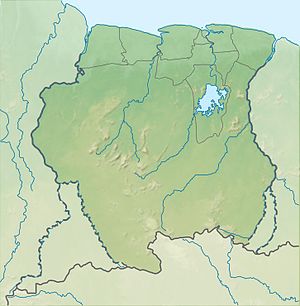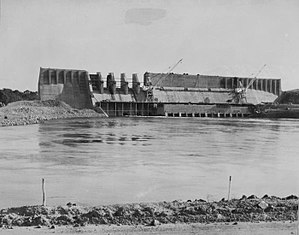Brokopondo reservoir
| Brokopondo reservoir | |||||||||
|---|---|---|---|---|---|---|---|---|---|
| Tree stumps in the reservoir; the trees were not felled when they were dammed | |||||||||
|
|||||||||
|
|
|||||||||
| Coordinates | 4 ° 48 '48 " N , 55 ° 4' 19" W | ||||||||
| Data on the structure | |||||||||
| Construction time: | 1960-1964 | ||||||||
| Height above valley floor: | 54 m | ||||||||
| Height above foundation level : | 66 m | ||||||||
| Building volume: | 0.848 million m³ | ||||||||
| Crown length: | 12 000 m | ||||||||
| Data on the reservoir | |||||||||
| Water surface | 1 560 km² | ||||||||
| Storage space | 20,000 million m³ | ||||||||
| Catchment area | 12 200 km² | ||||||||
| Location map | |||||||||
| Construction of the dam, 1963 | |||||||||
The Brokopondo reservoir (locally: Brokopondostuwmeer , officially: Prof.-Dr.-Ir.-W.-J.-van-Blommestein-See , ndl. Prof. Dr. Ir. WJ van Blommesteinmeer ) is a reservoir in Suriname . He is named after the on Java -born Dutch hydraulic engineering - engineering Willem Johan van Blommestein . With an area of around 1,560 km² (a little more or less depending on the water level), the lake is one of the largest reservoirs in the world.
Details of the structure
The dam , built between 1960 and 1964, reaches a height of 54 m and dams the Suriname River near the town of Brokopondo . In the vernacular it is therefore simply called Brokopondomeer . The length of the dam, including the secondary dams on the edge of the reservoir, is a total of 12 kilometers. The catchment area is 12,200 square kilometers.
In 1965 the hydropower plant was put into operation; the reservoir did not reach its optimal water level until 1971.
The reservoir was built to enable the processing of bauxite into alumina and further into aluminum in the aluminum smelter of Paranam by the Suriname Aluminum Company (Suralco) - a subsidiary of the Aluminum Company of America ( Alcoa ); Part of the electricity generated is passed on to the capital Paramaribo .
Relocation
According to official information, around 6,000 people had to be resettled due to the flooding of residential areas; according to information from the Saramaccans affected , it was up to 10,000 people. The largest place affected by the resettlement was the wholee village with about 2,000 inhabitants. Most of the new villages ( transmigratiedorpen ) emerged downstream from the dam: u. a. Brownsweg , Klaaskreek, Nieuw Lombè and Nieuw Koffiekamp.
Operation Gwamba was carried out in 1964 and 1965 for the fauna affected by the flooding .
Use
In addition to the generation of electricity, other advantages of the dam are the easier development of the inland, the pushing back of the salt water border in the Suriname River, better irrigation possibilities on the lower reaches of the river in the dry season, creation of tourist opportunities and fishing.
However, especially since the rise in the price of gold, the environment and nature around the reservoir are increasingly endangered by gold prospectors and the use of mercury .
Trees
After the required approval from the dam operator Suralco and the concession from the responsible ministry had been received, Brokopondo Watra Woods International NV (BWWI) began harvesting the flooded tropical woods in May 2004 . The trees are felled down to a water depth of 35 m by divers with compressed air chainsaws and processed in sawmills on the bank. Due to the long storage under water, this wood is said to be of higher quality than freshly felled trees.
Other names
- Afobaka reservoir
- Blommesteinsee
New operators
Suralco and its parent company, Alcoa Corporation , will end their bauxite operations in Suriname in 2016/17. Alcoa and the Surinamese state agreed in 2015 that the hydropower plant would be transferred to Suriname on December 31, 2019.
See also
literature
- CFA Bruijning, J. Voorhoeve (main editor): Encyclopedie van Suriname. Elsevier , Amsterdam, Brussels 1977, ISBN 90-10-01842-3 , pp. 73-74.
- John Walsh: The waters are rising. 10,000 animals are to be saved. Müller, Zurich, Stuttgart, Vienna 1969. (German translation of the US edition Time is short and the water rises from 1967)
Web links
Individual evidence
- ^ Ministry of Regional Development, February 1, 2014 50 Years of Resettlement Remembrance Day ( Memento of March 10, 2014 in the Internet Archive ) Dutch, accessed on December 4, 2015.
- ↑ Franz Jussen: Expelled from Paradise . ( Memento from March 13, 2016 in the Internet Archive ) In: continents . March / April 2014, pp. 12-17, here p. 14, accessed on March 10, 2014.
- ↑ stauseeholz.de accessed on April 4, 2018.
- ↑ De Ware Tijd from January 6, 2017 Dutch, accessed on January 6, 2017.



